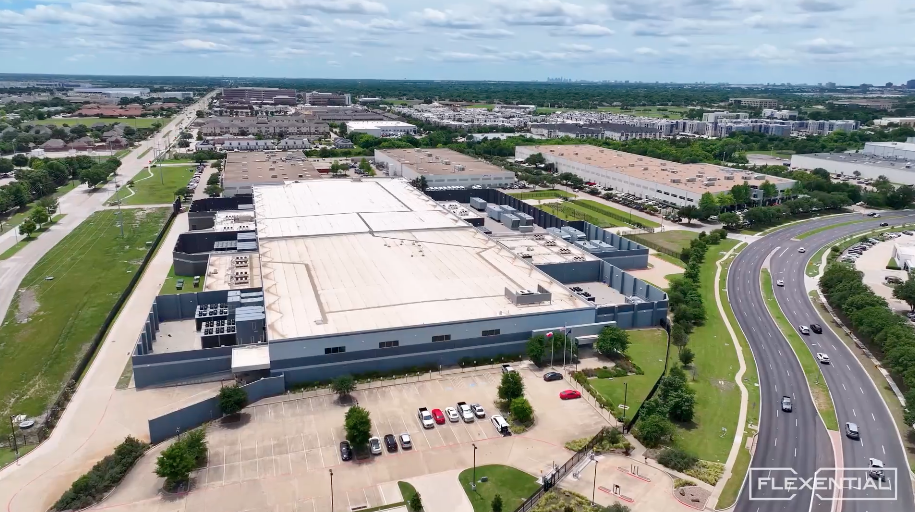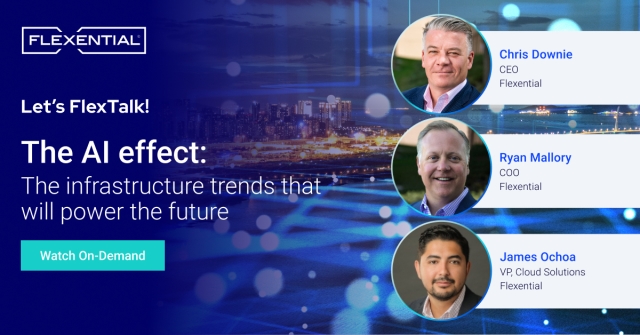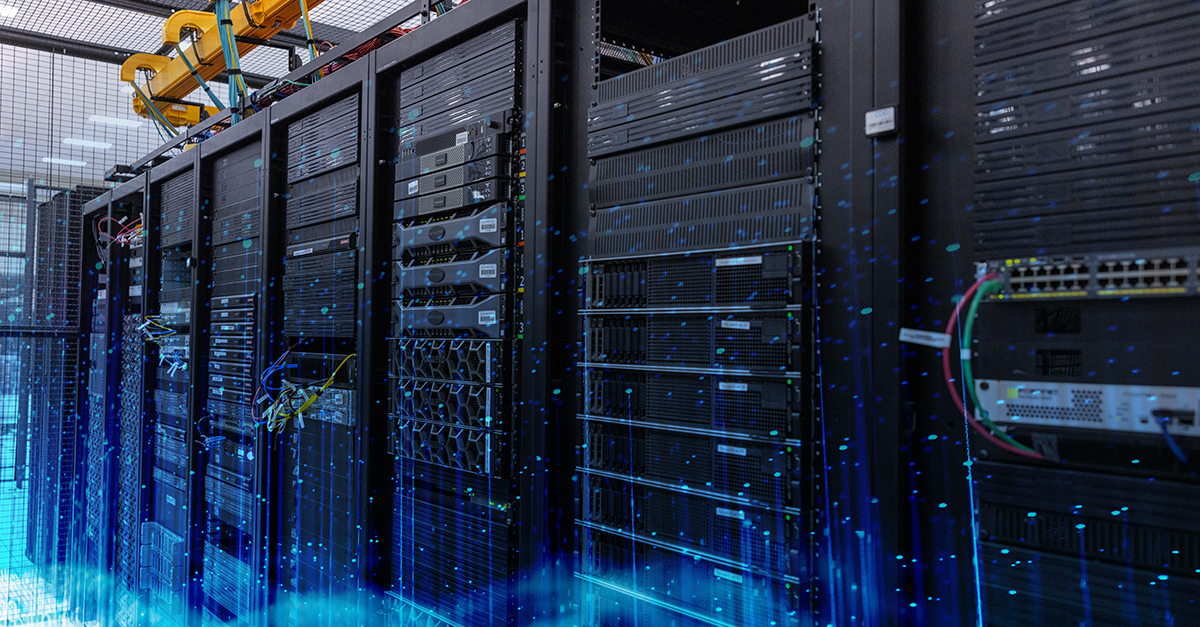Navigating AI data center trends
Strategies for power, security, and talent management

The rapid evolution of AI-driven infrastructure is reshaping the landscape of data centers and enterprise operations. As we move into 2025, the demand for advanced infrastructure to support AI applications is unprecedented. This transformation concerns technology, addressing the significant energy demands, and ensuring robust cybersecurity measures.
In a recent FlexTalk webinar, The AI effect: The infrastructure trends that will power the future, Flexential thought leaders tackled the critical topics and strategies influencing IT infrastructure, sustainability, and security in 2025. Here’s a recap of the key issues facing enterprises today, and the strategies they recommend to overcome them.
Introduction: The AI effect on data centers
In today's competitive market, enterprises constantly seek ways to differentiate themselves and stay ahead. One of the most pressing challenges they face is the limited availability of resources, particularly power. The exponential growth of AI and other high-computing workloads requires enterprises to adopt new strategies to secure the necessary resources. This shift in mindset and planning moves beyond the traditional 12-month buying cycle to a more forward-thinking approach.
To ensure resilience and continuity, businesses must navigate a complex web of environmental and cybersecurity dynamics. Environmental risks, such as extreme weather events, are becoming more frequent and severe, necessitating robust strategies to protect physical infrastructure and personnel. Concurrently, the rise of cyber threats demands stringent cybersecurity measures to safeguard sensitive data and maintain operational integrity. A comprehensive approach addressing physical and logical vulnerabilities is essential for organizations striving to adapt to these challenges.
AI data center trends and challenges
Power: Addressing energy demands
The exponential growth in demand for AI data center capacity is a pressing trend, with McKinsey reporting an average annual increase of 33% until 2030. This surge requires more power for data centers and a redesign of server infrastructure to handle increased density and energy consumption. Meeting these power requirements is crucial, but ensuring the infrastructure’s sustainability and resilience is equally important.
“The world is all about power consumption right now. The data center marketplace is focused on finding that next pivotal point in the global economy that can generate and provide power to meet the exponential demand of AI-driven infrastructure.”
—Ryan Mallory, Chief Operating Officer, Flexential
Cybersecurity in the AI era: Protecting critical infrastructure
Cybersecurity is also a critical concern. As computing complexity rises, so does the risk of cyber threats. Significant global incidents have already occurred, underscoring the need for robust disaster recovery and cybersecurity measures. Enterprises must invest in advanced security protocols to protect their data and maintain operational continuity. This includes securing infrastructure and implementing comprehensive disaster recovery plans.
Bridging the talent gap: AI’s workforce challenges
The industry's talent gap presents a significant challenge. Advancing AI technology creates a growing need for skilled professionals to manage and operate complex systems. Enterprises must invest in training and development programs to equip their workforce with the necessary skills. Highlighting the exciting opportunities and critical role of data centers in technological advancements is also essential for attracting new talent.
AI for efficiency: Optimizing data center operations
AI plays a crucial role in enhancing operational efficiency. AI tools help enterprises optimize operations, reduce costs, and improve decision-making processes. For instance, AI enhances cybersecurity by identifying potential threats and vulnerabilities in real time and manages energy consumption by optimizing resource use. Enterprises that effectively leverage AI will better navigate market complexities and stay ahead of the competition.
“AI is a tremendous tool—not one that will make roles or markets obsolete, but one that will accelerate the consumption of information for decision-making. The challenge now is helping enterprises understand how to effectively integrate and leverage it.”
—Ryan Mallory, Chief Operating Officer, Flexential
Planning for AI infrastructure amidst hyperscaler dominance
The dominance of hyperscalers in the market has complicated the situation for enterprises. These large players secure power capacity 18 to 36 months in advance, leaving little room for smaller enterprises to maneuver. To address this, enterprises must plan their resource needs well. This involves creating reservation capacities and thinking beyond the immediate future. By doing so, they can ensure they have the necessary resources to support their growth and avoid being shut out by larger competitors.
Planning for capacity
One key area for enterprises to focus on is the deployment of AI infrastructure. AI growth is exponential, not linear. Enterprises anticipating a 5-10% annual growth in their AI infrastructure should be prepared for much higher growth rates. This requires long-term planning and ensuring they have the necessary power and cooling solutions. Liquid cooling, for example, is becoming increasingly important as AI workloads generate higher densities and require more efficient cooling solutions.
Sustainable strategies
Enterprises must prioritize sustainability in their planning. The data center industry consumes significant power, and there's a growing need to use renewable energy sources. Companies should explore technologies and partnerships to leverage sustainable energy solutions, including nuclear power. Despite regulatory challenges, nuclear power offers a promising solution for meeting future energy demands.
“By 2030, 35% of the North American data center industry aims to be powered entirely by renewable energy. Meeting the soaring energy demands of AI will require not just innovation but also public-private partnerships to enable a more sustainable future.”
—Chris Downie, Chief Executive Officer, Flexential
Navigating risks
Resiliency and security are also crucial. With evolving cyber threats, robust disaster recovery and cybersecurity measures are essential to ensure business continuity and protect against disruptions. Environmental changes impact data center locations, necessitating new strategies for resilience against natural disasters.
Managing environmental risks requires proactive measures to mitigate extreme weather impacts. Companies are deploying resources to affected regions in advance, allowing local teams to focus on their families while external support handles operations. This approach protects physical assets and prioritizes employee well-being. Additionally, facilities' advanced monitoring devices and biometrics demand heightened cybersecurity protocols to prevent unauthorized access and data breaches.
Future-proofing AI infrastructure
Artificial intelligence (AI) is transforming the business landscape, driving the need for regional diversification and advanced computing capabilities. Like the evolution of the public cloud, AI emphasizes geographical distribution to enhance data accessibility and processing efficiency. As AI applications grow, businesses must adapt to new customer expectations and market dynamics, expanding data center capacity and exploring emerging markets. This shift highlights the importance of long-term planning and strategic infrastructure investments.
Flexibility and innovation are key as organizations navigate AI deployment complexities. Enterprises often feel overwhelmed by the technological demands of integrating AI into existing frameworks. To address this, companies must leverage strong support teams and professional services to guide customers through AI adoption. By fostering a collaborative environment and providing expert resources, businesses can demystify AI and empower customers to harness its potential effectively.
Conclusion
The AI-driven transformation of infrastructure introduces significant opportunities and challenges for the industry. Key areas such as the demand for advanced infrastructure, robust cybersecurity measures, and addressing the talent gap require focused attention. Enterprises must invest in innovative solutions and comprehensive training programs to maintain a competitive edge. Effectively leveraging AI can enhance operational efficiency, sustainability, and infrastructure resilience. Additionally, adopting a forward-thinking approach emphasizing sustainable energy solutions and long-term planning will enable enterprises to navigate future challenges. Addressing environmental risks and cybersecurity while investing strategically in infrastructure and customer support will be crucial for thriving businesses. By prioritizing innovation and collaboration, companies can mitigate risks and unlock new growth opportunities in this dynamic market.
Explore the complete FlexTalk on-demand to uncover invaluable insights into navigating AI data center trends for your IT infrastructure!






